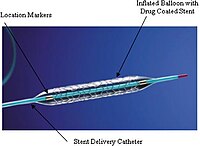
Photo from wikipedia
Background: Displaced medial epicondyle fractures are treated with open reduction and internal fixation with K-wires or screws. Rates of implant prominence, failure, or non-union reported are considerable. Magnesium screws have… Click to show full abstract
Background: Displaced medial epicondyle fractures are treated with open reduction and internal fixation with K-wires or screws. Rates of implant prominence, failure, or non-union reported are considerable. Magnesium screws have demonstrated biocompatibility, osteoconductivity, and high pull-out strength. The aim of this study was to compare surgical fixation of medial epicondyle fracture using resorbable magnesium Herbert screws to K-wires, in skeletally immature patients. Methods: A retrospective analysis was performed from January 2015 to April 2020. Inclusion criteria were as follows displaced medial epicondyle fracture, <15 years, and absence of concomitant ipsilateral upper limb fractures. Two consecutive cohorts based on fixation device were made: Group A (wires) and Group B (magnesium screws). Alignment, pain, range of motion, Mayo Elbow Performance Score, and radiological healing were assessed. Results: A total of 27 patients were included: 15 in Group A and 12 in Group B. Groups were comparable for age and sex. Mean follow-up was higher in Group A (38.73 ± 3.15 vs 26.18 ± 4.85 months; p < 0.001). No significant differences were observed regarding range of motion, alignment, pain, and Mayo Elbow Performance Score, with excellent results in both groups. Two patients in Group A developed a deep wound pin site infection requiring antibiotics. X-rays revealed three cases of non-union in Group A and one in Group B, all of them asymptomatic. No patient required a second surgical procedure. Conclusion: Open reduction and internal fixation of medial epicondyle fractures with magnesium screws showed comparable results to a widely accepted procedure such as the use of K-wires, potentially with a lower incidence of non-union and infection. No adverse reactions were recorded. Level of evidence: level III.
Journal Title: Journal of Children's Orthopaedics
Year Published: 2022
Link to full text (if available)
Share on Social Media: Sign Up to like & get
recommendations!